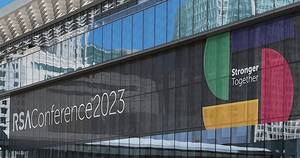Corporate
Reflections on the 2023 RSA Conference: Trends, Takeaways, and the Shift-Left Approach to Cybersecurity


The 2023 RSA Conference brought together over 45,000 cybersecurity professionals from around the world to discuss the latest trends, technologies, and best practices in the field. Key themes that emerged at the conference included the intersection of cybersecurity and artificial intelligence (AI), the rise of software risks, and the "shift-left" approach to cybersecurity.
Key takeaways:
- AI risks are ever-evolving, and the methods to reduce those risks are not far behind.
- Software risk can be mitigated through a combination of people, processes, and technology.
- A "shift-left” approach integrates security into the process to reduce the strain on resources.
- Cybersecurity professionals must stay up to date on the latest threats and technologies to remain effective in our mission to reduce cybersecurity risks.
This year’s RSA Conference was a hotbed of activity for cybersecurity professionals looking to stay ahead of the curve and learn about new industry trends and technologies. This year's conference was particularly interesting, as it focused heavily on the intersection of cybersecurity and artificial intelligence (AI). Here are some of the latest trends, technologies, and key takeaways from the conference.
Artificial Intelligence
One of the most significant topics of discussion at the conference was the cybersecurity risks surrounding AI technologies. As AI continues to become more prevalent in our daily lives, it also becomes more attractive to cybercriminals. Hackers can use AI to automate attacks, making them faster and more efficient.
AI can be used to create more convincing phishing emails and deepfakes that can be used to spread misinformation. But there is also the human element: there are noted instances where propriety or sensitive information is entered into AI tools. If this information is not properly protected, or the AI tool itself is compromised, it could be accessed by unauthorized individuals, including cybercriminals or competitors.
However, the conference also focused heavily on ways to mitigate these risks. One strategy is to use AI to fight AI. Many companies now use machine learning algorithms to detect and respond to cyberattacks in real-time.
Another strategy is to focus on building more secure AI systems from the ground up. This includes implementing security controls at every stage of the AI development process and using data encryption to protect sensitive data. Organizations can mitigate these risks by carefully vetting AI tools and vendors, implementing appropriate access controls and security measures, and regularly monitoring for any suspicious activity or vulnerabilities.
Software risk roundtable by Veracode
Veracode hosted an interactive panel discussion on managing software risk with innovative solutions. Experts from AWS, Optiv, ServiceNow, Cybeats, and Coalfire’s Vice President of Strategy, Privacy, and Risk, Mike Eisenberg.
This panel discussed the importance of mitigating software risk through leveraging partnerships, automation techniques, and a cybersecurity program foundation. These elements will allow for secure coding practices, code analysis, and ongoing testing and monitoring to ensure that software remains secure over time.
Shift-left
Another significant theme that emerged at the 2023 RSA Conference was the "shift-left" approach to cybersecurity. This approach emphasizes the importance of including cybersecurity practices and considerations early in the software development life cycle (SDLC) process.
By integrating security into the SDLC from the beginning, organizations can identify and address vulnerabilities and other security issues before they become bigger problems down the line, saving time and resources, as well as overall security posture. Shift-left also involves breaking down silos between development and security teams and fostering a culture of collaboration and communication.
This approach was discussed in various sessions and panels throughout the conference, highlighting its growing importance in cybersecurity.
Other hot topics at the conference included zero-trust security, cloud security, and the rise of ransomware attacks. Zero-trust security is a model that assumes that every user and device is a potential threat and, as such, should not be trusted by default.
This model is becoming increasingly popular as organizations look for ways to improve their security posture in the face of evolving threats.
Coalfire at RSA 2023
In addition to speaking in the Veracode panel, we were proud sponsors at RSA. In case you missed us, we were the ones with the jumbo-sized notebook as our booth. We enjoyed discussing Coalfire’s latest and greatest innovations with cyber professionals who came by our booth, including the Department of Defense’s CIO, Stacy Bostjanick.

We also had the pleasure of accepting THREE awards in Cyber Defense Magazine's 11th anniversary of the Global InfoSec Awards: Editor’s Choice for Penetration Testing, Hot Company for Vulnerability Management, and Most Innovative for Vulnerability Assessment, Remediation, and Management. Coalfire’s Patrick Kehoe, Mark Carney, and Kyle Hankins walked the “red carpet” and accepted the awards on behalf of #coalfirenation.
In conclusion, the 2023 RSA Conference was a success and, as always, an excellent opportunity for cybersecurity professionals to learn about the latest trends, technologies, and best practices in the field. From AI to zero-trust security, there was no shortage of interesting topics to discuss. Cybersecurity is not something that can be solved by any one person or organization alone. Cybersecurity is a constantly evolving field; it requires a community-wide effort to stay ahead of the latest threats, develop countermeasures, and improve technologies to solve the world’s most complex cybersecurity challenges. Thank you to everyone who stopped by our booth! See you at RSA 2024!